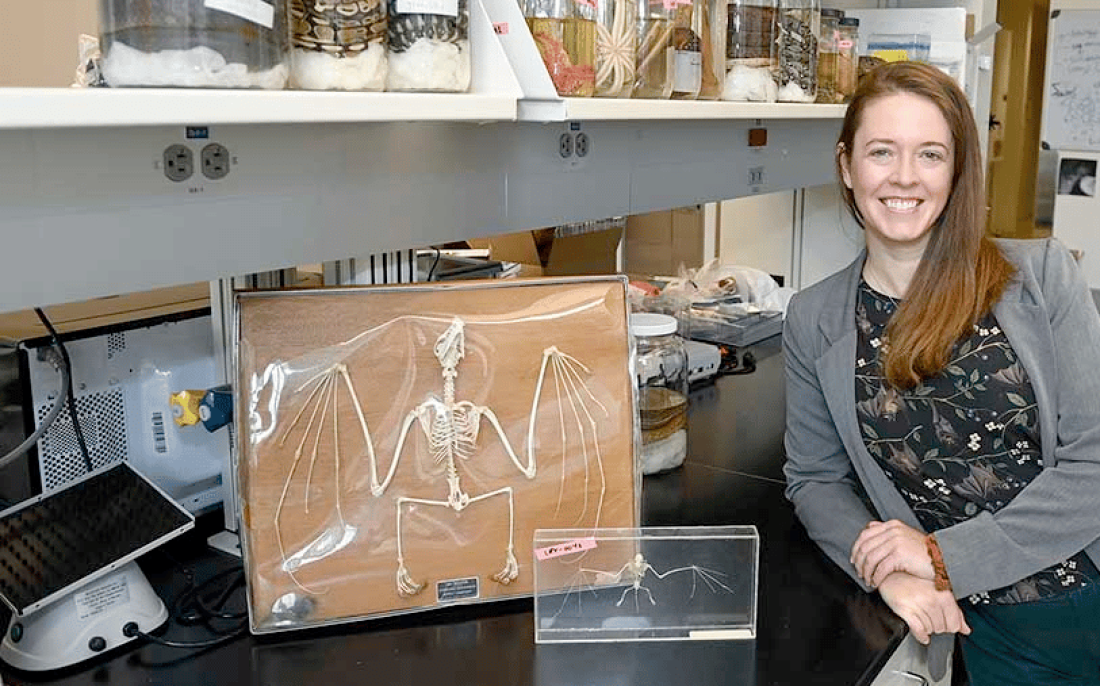
Like It or Not, We Need Bats
“It’s never been more important to understand how zoonotic bacteria and viruses circulate in the environment. The COVID-19 pandemic continues to teach us this.”
Bats get a bad rap. They are known to host more zoonotic viruses — those that spread between people and animals — than any other mammal species. In fact, they are the originating hosts of several disease-causing microbes, including those that cause flu and common colds. At the same time, they are essential for maintaining ecosystem health. Notably, they sustain forest health by dispersing seeds from fruit and pollinating flowers; and they control pests through daily consumption of millions of tons of insects.
“This paradox emphasizes the urgent need to communicate bats’ essential role in the ecosystem — as we work to understand their immunology and ecology, and characterize distribution of viral reservoirs at the global scale,” said Laurel Yohe, assistant professor of bioinformatics. “Bat habitats and populations need protection to minimize disturbance from humans and prevent zoonotic transfer of viruses to people or human-consumed livestock and to prevent spillover of human-evolved viruses back to bats.”
Fast bat facts
Yohe, whose students eagerly accompany her in the field and lab, shares how bats contribute to a balanced ecosystem, what science is learning from them about contagious and metabolic diseases, and the existential challenges they face:
- Bats are found on every continent except Antarctica and range in size, color, and habit. In North Carolina there reside 14 of 1,000 total bat species, with a few others migrating in and out. Some, like the big brown bat, are quite common and live in roosts with many other bats. The hoary bat has stunning coat colors and is more solitary. Others are rare and even endangered, such as the Virginia big-eared bat. All play special roles in the Piedmont ecosystem, especially in regard to insect control.
- All bats in North Carolina eat insects, but others throughout the globe feed on fruit, nectar or blood. A focus of Yohe’s research is understanding how bats can evolve from consuming insects to other food resources. How is a flying mammal able to sustain itself almost exclusively on sugar water? And how does it do this without developing diabetes, given the amount of nectar it consumes in a single night? Another focus is on the ways bats find food. “Echolocation is great for moving targets in the open air,” she says. “But what about when trying to find a ripe fruit under a stagnant leaf in a cluttered forest while flying in the dark?
- Bats are not flying mice. In fact, humans are more closely related to rodents than are bats. “I like to tell my students that bats are nothing but ‘flying horse-dogs’ as their closest living relatives are carnivores — cats, dogs, bears — and ungulates — hoofed animals like horses and giraffes,” Yohe said. She explains that one of evolution’s greatest mysteries is how bats evolved from their terrestrial ancestors. Contrary to what is known about the evolution of birds and dinosaurs, the earliest bat fossils — dated back 50 million years — look a lot like modern bats with their ability to fly. “We need more paleontology expeditions targeting this transition period to try to discover what the evolution of flight in mammals may look like.”
- Bats age gracefully. Generally, in mammals and birds, the larger the animal the longer it lives. Many bats, however, are similar in size to mice, yet live drastically longer. In addition, they tend to not show signs of cancer or other age-related disease. Both of these factors are likely due to bats having relatively few predators. With lower predation pressure, bats take their time to reproduce, having only one or two babies at a time and usually only once per year. Conversely, mice reproduce very quickly with many offspring due to the high chance they will be eaten by a hawk or fox. “Bats serve as a good model for trying to understand the aging process and naturally evolved solutions to overcome the negative health consequences of getting older,” she said.
- Bats possess exceptional immune systems. It has been known for decades that bats circulate beta-coronaviruses, which are related to COVID-19. A central component of Yohe’s research is exploring how bats can host these viruses and not get sick. One explanation might be related to their relatively small genomes and the fact that they have lost many genes related to primary inflammatory responses, which often cause disease in humans following pathogen infection. “I look at everything from their genomes to their anatomy to try to better understand how they have evolved to stay healthy,” she said. “An early hypothesis lies in their ability to fly; it is exceedingly demanding on the metabolism as are the required evolution of DNA repair mechanisms and coping with high energy demands on the body.”
- Many bats in North America are being threatened by a cold-loving fungus. This fungus, which is decimating bat populations while they hibernate in their roosts, was brought unknowingly over the past decade to a cave in New York by humans and has spread rapidly throughout the United States and Canada. Bats that formerly were the most abundant in some regions are now deemed locally extinct. For example, North Carolina’s little brown bat used to be caught by the dozens. Now they are under consideration for being listed as federally endangered. “While bats have robust immune systems, the cells of invasive pathogens when it comes to fungi are difficult for the immune system to decipher versus their own,” Yohe said. “The impact is exceptionally challenging for bats to recover from because of some of their unique features, such as slow, low-number reproduction. Also, they are quite gregarious, allowing the powdery fungus to spread from one individual to another.”
COVID-19, COVID-19 Research, health research, North Carolina Research Campus
